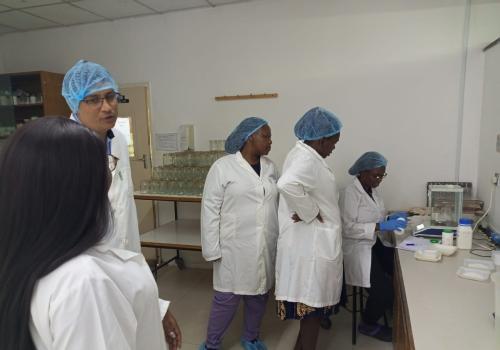The Southern African Development Community Plant Genetic Resources Centre (SPGRC) held a capacity building workshop in conservation, utilisation and documentation of Plant Genetic Resources (PGR) in Harare, Zimbabwe, from 13th to 17th February 2023.
The training workshop was aimed at capacitating curators, who are gene bank managers from SADC Member States, in using modern technologies and innovations in the conservation, collection and handling of plant genetic resources to boost agricultural production.
During the official opening, Dr Dumisani Kutyawo, the Chief Director in the Department of Research and Specialist Services in the Ministry of Lands, Agriculture, Fisheries, Water and Rural Development in Zimbabwe, said PGR was key to the realisation of the Region’s primary goal to achieve sustainable agricultural productivity. He urged other SADC Member States to promote community genebanks, saying they were important for food security at household level.
Dr Kutyawo said SADC Member States should embrace new technology and innovation in the conservation, collection and handling of plant genetics resources to boost agricultural production and ensure the ability of seeds to survive long periods of dry storage. He said there was a need to embrace new technologies such as tissue culture in conservation of genetic resources.
For many years, vegetatively propagated plant species had been neglected, but now these are being taken care of using appropriate technology such as tissue culture. It is important to continue to promote the use of advanced technology and tools while leveraging inter-disciplinary institutional linkages at the national, regional and international levels and the SPGRC remains strategically placed to foster such linkages, he said.
Speaking at the same event, the Head of the SPGRC, Dr. Justify Shava, told participants that the centre now had over 63 000 samples of crops from gene-banks in the Southern Africa region which form the core sources of food for the SADC people. He further explained that as a risk mitigation measure, the SADC Region, through its regional centre, has further duplicated these materials to the Svalbard Global Seed Vault in the Svalbard Archipelago in the North Pole.
With the devastating effects of climate change becoming more serious than ever before, embracing new technologies such as tissue culture in conservation of genetic resources is critical in preventing the loss of local crop varieties and erosion of local indigenous knowledge systems.
The regional training workshop was attended by participants from 13 SADC countries with support of key resource persons from International Cooperating Partners such as International Treaty on Plant Genetic Resources for Food and Agriculture (ITPGRFA) of the Food and Agriculture Organisation and the International Institute of Tropical Agriculture (IITA).
The SPGRC, which is headquartered in Lusaka, Zambia, is mandated to coordinate the promotion of conservation and utilisation of plant genetic resources in Africa. The SPGRC has been collecting different unique plant species in Southern Africa for more than 30 years and now holds more than 63 000 diverse crop and wild varieties as SADC steps up long-term efforts to conserve germplasm collections and develop new varieties resistant to climate change and other threats. A few years ago, the SADC gene bank had 18 000 unique varieties of seed in its storage from different Member States’ plant breeders.
The 63 000 different accessions, or species, of crops collected form the core sources of food for the people in the SADC Region. The accessions are safely stored in various gene banks in the SADC Region, with some duplicated at the regional gene bank in Lusaka and the Svalbard Global Seed Vault in the Svalbard Archipelago in the North Pole as a risk mitigation measure for SADC.
The SPGRC is unique as a regional gene bank mandated to mobilise, conserve and make available plant genetic resources using state-of-the-art technologies and standards, contributing to sustainable development, the environment and food security for the well-being of the people of SADC. This has been made possible, thanks to the political support that the SPGRC enjoys from SADC Member States, Among its major achievements, the SPGRC has over the years successfully duplicated more than 12 000 materials to the Svalbard Global Seed Vault, which acts as a risk mitigation strategy for the entire world.
SPGRC was established in 1989 to conserve all genetic resources in SADC for the benefit of Member States. It is located in Chongwe district of Lusaka, Zambia and coordinates the collection, conservation and sustainable use of plant genetics diversity for the benefit of present and future generations in SADC. SPGRC works with National Plant Genetic Resources Centres (NPGRCs) in each of the SADC Member States to contribute to food security and improved livelihoods and coordination of all activities.

